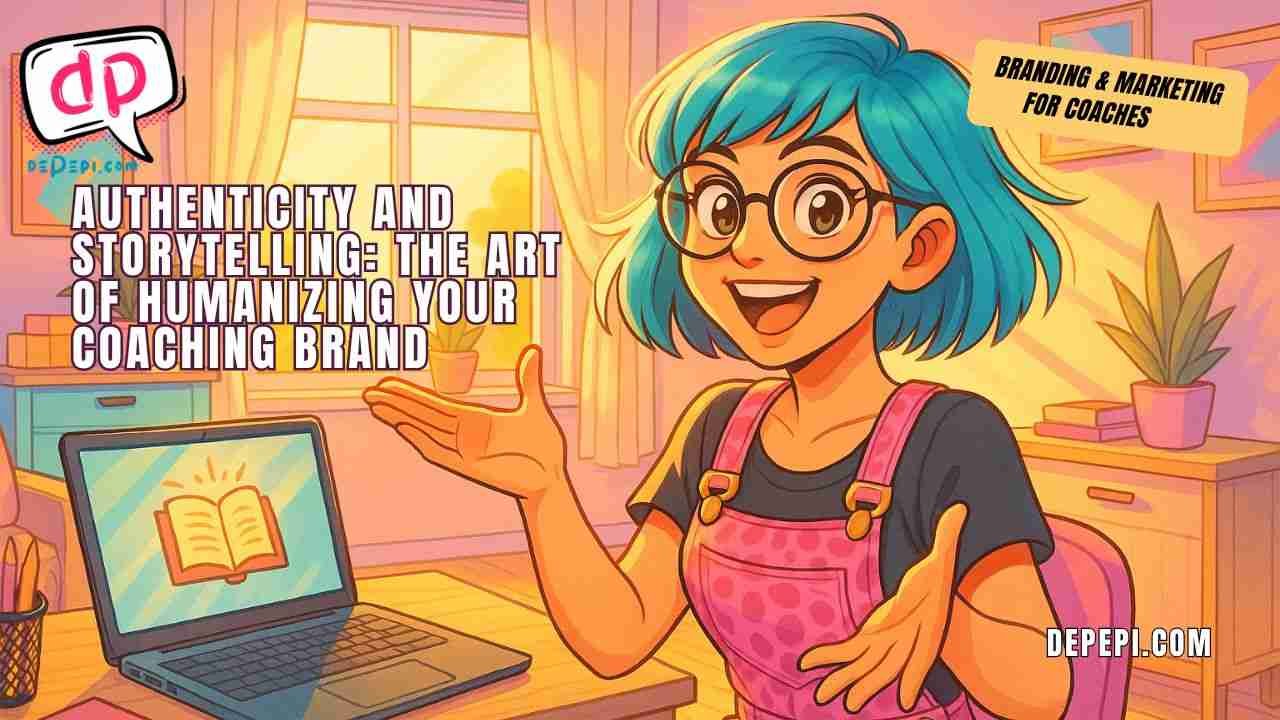Authenticity and Storytelling: The Art of Humanizing Your Coaching Brand

There’s a moment in every coach’s journey when marketing starts to feel…off. You know the moment. You’ve read the posts about “building authority” and “showcasing expertise.” You’ve followed the templates, optimized your bio, and posted inspirational quotes. However, despite all your effort, your feed feels flat. You need to push a bit of storytelling.
Why? Because modern clients aren’t just buying coaching packages anymore—they’re buying connection.
We are oversaturated with content, yet starving for something genuine. Clients don’t just want a coach with credentials; they want a guide who understands their world. They want someone who’s lived it, stumbled through it, and come out the other side with wisdom, not perfection.
This is where authenticity and storytelling come in. (Simply, it’s being yourself and telling your story.)
This isn’t about oversharing or turning your feed into a therapy session. It’s about crafting a brand narrative that’s grounded in truth, one that’s uniquely yours, and letting people see the person behind the coaching offer.
Why “Perfect” Coaches Struggle to Build Real Brands
In the past, coaches often positioned themselves as experts sitting at the top of the mountain, radiating polished professionalism and delivering the “right” answers. But today’s clients are wary of such coaches. They don’t want perfection; they want proximity, feel seen, heard, and understood.
When all you share is success, you build distance. When you add human context—your struggles, your lessons, your “why”—you build trust.
Consider the difference between reading:
“I help leaders optimize their productivity with a 5-step system.”
vs.
“I used to think working harder made me better. That belief almost cost me my health. Now I coach leaders to redefine success, so they don’t make the same mistake I did.”
The second version doesn’t just offer a service; it offers connection. It says, “I see you, because I’ve been you.” And that makes all the difference.
The Science Behind Storytelling
Storytelling works because it’s wired into our brains. Neuroeconomist Paul Zak’s research shows that when we hear stories—especially stories involving vulnerability—our brains release oxytocin, the “connection chemical.” We feel empathy and we lean in. We remember the storyteller, sometimes for years, even when we forget the facts.
Coaching is a deeply human exchange. If you want people to trust you with their transformation, you must give them something human to connect with. Facts and figures won’t get you there. Stories will.
Sharing Your Journey (Without Making It About You)
One of the biggest hesitations coaches have around storytelling is the fear of making it too much about themselves.
And that’s valid. Clients don’t hire you to hear your life story on repeat. They hire you because they believe you can help them change theirs.
So, how do you balance personal narrative with client relevance?
The key is shared humanity.
When you tell your story, frame it in a way that mirrors the client’s journey. Talk about where you were before you found coaching, the lessons you learned, the challenges you still face, and how you grew from them. Then tie it back to the work you do now.
For example:
“I spent a decade helping companies grow. But behind the scenes, I was burnt out and quietly wondering if success was supposed to feel this empty. Coaching didn’t just change my career; it changed my life. Now I help high-achieving professionals create growth that actually feels good.”
See the difference? The story isn’t “look at me.” It’s “me too.” It invites clients to see themselves in your narrative, and that’s where real trust is built.
How Storytelling Builds Communities, Not Just Transactions
When your brand is rooted in story, not just services, you stop chasing cold leads. You start attracting a community.
These are the people who:
Stay in your orbit even when they’re not ready to buy.
Share your posts because they resonate personally.
Refer you to friends because they trust your voice.
Remember you months later because your story stuck.
This is why storytelling brands aren’t just successful—they’re sustainable. They don’t rely on constant funnels and aggressive lead generation tactics. They grow through emotional equity. Connection outlasts content hacks every time.
When Vulnerability Goes Too Far
Of course, the rise of authenticity in branding comes with a shadow side. You’ve probably seen it yourself: the coach who shares every raw detail of their personal life, or who turns every post into a live journal entry.
At some point, that stops building trust and starts raising eyebrows.
The line between authenticity and oversharing isn’t always obvious, but it’s important. You’re a coach, not a confessional booth. Clients need to trust your humanity and your professionalism.
So how do you walk the line?
Think of it like this:
Share the lessons from the scar, not the open wound.
Speak from a place of reflection, not reaction.
Reveal enough to connect, but not so much that it makes the client worry about your stability.
Your vulnerability should serve the client’s growth, not your own catharsis.
Building an Authentic Brand Without Burning Professional Boundaries
If you’re wondering how to put this into practice, start by asking better questions before you post.
Before you share a personal story, ask:
Why am I sharing this? Is it for connection, or to get something off my chest?
Will this help my audience feel seen, or will it make them worry about me?
Am I positioning myself as a guide or a main character?
Is this aligned with the values and mission of my coaching brand?
If the answer suggests a focus on client service and connection, share it. If it feels self-serving or unresolved, maybe hold back.
You Don’t Need to “Go Viral.”You Need to Be Remembered
One of the myths of modern marketing is that you need huge reach to make an impact. You don’t.
You need depth, not just breadth.
A single story that resonates will do more for your brand than ten perfectly optimized posts that don’t say anything human.
Think about it: people forget stats, but they remember stories. They forget pitches, but they remember moments when they felt seen.
That’s what turns followers into clients. And that’s what keeps clients around long after the engagement is over—they become part of your community, not just a line on your calendar.
Why Your Story Is Your Brand
You can spend months refining your logo, choosing fonts, and crafting polished taglines. But in the end, your coaching brand isn’t about aesthetics. It’s about connection.
Your story—shared with intention, courage, and care—is the glue that holds your brand together.
Not because it’s perfect. But because it’s real.
In a world craving authenticity, the coaches who thrive aren’t the ones with the slickest marketing. They’re the ones who are willing to say:
“This is who I am. This is why I do this work. And if you’re ready, I’ll walk with you.”
That’s the kind of brand that lasts.
Need some Help?
Join Branding and Marketing for Coaches and get all the information you need to shine online.






